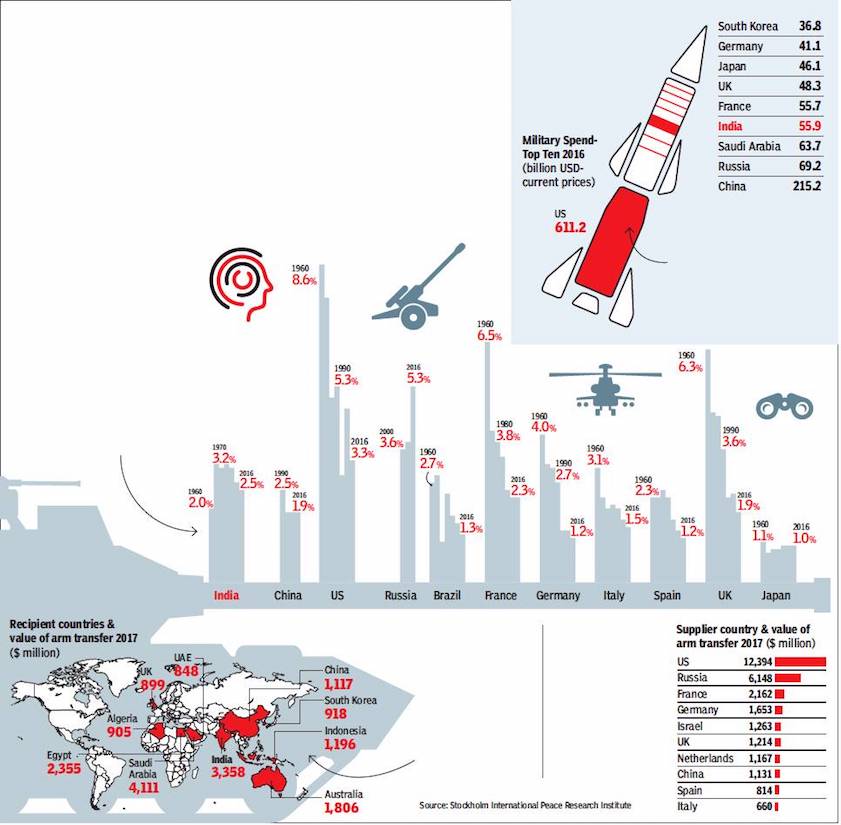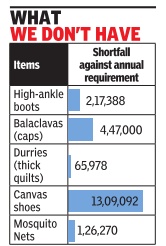Defence expenditure, defence economy: India
This is a collection of articles archived for the excellence of their |
Contents |
Defence expenditure of India
2010-20/21
Armaan Bhatnagar, January 30, 2021: The Times of India
India's defence spending in 7 charts
NEW DELHI: Defence allocation is expected to be a key focus area of Budget 2021 amid wide expectations of a significant hike to tackle the threat posed by China.
Last year, the government had set aside Rs 4.71 lakh crore for the defence sector, with capital outlay — required for miliary modernisation — witnessing just a marginal increase. This year, however, the defence sector is eyeing a generous capital infusion amid a heightened need to strengthen the military infrastructure in view of the ongoing border conflict with China.
With just two days left for finance minister Nirmala Sitharaman's budget presentation on February 1, we look at how the government has been spending on defence over the years ...
Last year, the government's allocation to the defence ministry was the highest among all ministries at 15.5% of the total budget expenditure.
India's overall defence spending has witnessed an average growth rate of 9% in the last 10 years.
If the government sticks to this trend, at the very least the defence budget this year would likely exceed the Rs 5 lakh crore-figure.
However, in terms of military reforms and modernisation, all eyes will be on the funds allocated for capital expenditure.
Army biggest stakeholder
The Indian Army, with its overwhelming size, continues to be the biggest stakeholder in the defence budget among the three forces.
In last year's budget, almost 56% of the total defence outlay was earmarked for the Indian Army. The Air Force and Navy were allocated 23% and 15% respectively.
But the interesting thing here is that the Army's capital share was the lowest among the three forces.
Out of the total amount allocated for the Army, only 18% constituted capital expenditure while the rest was meant for revenue expenditure
Revenue expenditure includes expenses on payment of salaries and maintenance of establishments while the capital expenditure involves the purchase of new weapons, platforms and military hardware.
According to Institute for Defence Studies and Analyses (IDSA), the Army's capital share has been on a constant decline over the last few years since the high of 26% in 2007-08.
Meanwhile, the Air Force's capital share was the highest at 59% on the back of the government inking big-ticket deals to bolster India's air power.
Defence as proportion of GDP
Despite a nominal year-on-year growth rate, the defence budget appears to be somewhat underwhelming when viewed as a proportion of India's Gross Domestic Product (GDP).
According to last year's figures, the overall defence budget was just 2.1% of the then estimated GDP. This was the lowest figure since the early 1960s.
In fact, over the last few years, India's defence budget as a proportion of its GDP has been on a decline.
Military experts believe that India should allocate at least 2.5% of its GDP to defence expenditure for building requisite deterrence against China and Pakistan.
Slow pace of modernisation
The modernisation of India's 1.5 million strong armed forces has witnessed slow progress in the last few years due to ballooning salary and pension bills.
In 2010, salaries and pension took up nearly half the total defence budget at 49%. This increased by 10 percentage points to 59% in 2019.
According to IDSA, the rising manpower cost has posed a hindrance to the much-needed modernisation of military.
In last year's budget, the capital outlay for new weapon systems and defence modernisation was Rs 1,18,555 crore, much lower than the Rs 2,18,998 crore revenue expenditure for day-to-day running costs, salaries and the like.
NDA vs UPA
As a proportion of the total budget expenditure, India's defence spending was the highest in 2000-01 under the then Atal Bihari Vajpayee government at 16.73%.
The Manmohan Singh-led UPA government began its term by setting aside a handsome chunk for the armed forces in its first couple of years. But the proportionate spending fell to an average of 13% in its later years. Similarly, the Narendra Modi government set aside an average of 12% of the total budget for defence in its initial years. However, the proportion fell to 11.62% in 2018 and then further to 10.96% in 2019, the lowest in the last two decades.
Last year, the spending picked up again when the defence ministry was allocated the highest sum among all the other sectors at 15.5% of the total budget expenditure.
Defence expenditure of India, China, major countries
2017
Defence spend as percentage of GDP has fallen world over, March 26, 2018: The Times of India

Defence expenditure as a percentage of the GDP
Defence expenditure in absolute terms
The major arms suppliers
The major arms recipients
From: Defence spend as percentage of GDP has fallen world over, March 26, 2018: The Times of India
India’s defence forces have expressed unhappiness over the allocation for them in the Union Budget which, at 1.56% of the GDP, was the lowest since 1962, when India and China fought a war. But the defence budget as a part of the GDP has actually been shrinking across the world...
Is India the only country whose defence bill as percentage of GDP has reduced?
• Government allocated Rs 2.74 lakh crore for defence in the 2018 budget. This will amount to 1.56% of the country’s GDP, making this allocation the lowest ever in terms of share of GDP. The analysis of budget allocations as a percentage of GDP for other major economies shows a similar pattern. As an economy grows, the proportion of its defence expenditure as compared to its overall size is bound to fall. This pattern is followed in most of the countries.
Are these countries making their own armaments?
• No. Many of these countries that top defence expenditure are dependent on import of defence equipment. In 2017, India was the world’s second-largest ar ms importer.
Which are the world’s largest arms suppliers?
• US followed by Russia are the world’s largest arms suppliers. Together they dominate the global arms market by a huge margin as compared to other countries.
In absolute terms, which country spends the highest on defence?
• US by far spends the highest on its defence. America’s total defence expenditure is roughly equal to the defence expenditure of the next nine highest- spending countries.
Equipment
Shortage of items: Indian Army
2015
Army needs 4L balaclavas, 2L boots
Chethan Kumar, Jan 08 2015
With one of the worst winters in the pipeline, the Indian Army is facing a shortage of items like high-ankle boots and balaclavas, lakhs of which still need to be procured. Air Marshal PP Reddy , chief of Integrated Defence Staff,said India needs to be prepared for war on both fronts, China and Pakistan. But how equipped are our soldiers in high-altitude regions? The third report of the standing committee on defence 2014-15, submitted on December 22, 2014 points that there's a shortage of 2.17 lakh boots (high ankle), 4.47 lakh balaclavas and 65,978 durries (thick cotton quilts), all basic requirements in high-altitude areas. Besides, there's a shortage of 13.09 lakh canvas shoes and mosquito nets.
Member of Parliament from Belagavi and committee member Suresh Angadi told TOI, “This has been plaguing the Army for a while now. Even when Atal Bihari Vajpayee was Prime Minister, strict instructions were given by the government to procure all the necessary articles for soldiers but it has not happened. Even now, we've told officials to expedite the pro curement process.“
The report quoting ViceChief of Army Staff (VCOAS) Lt Gen Philip Campose on how the Army is managing the Mountain Strike Corps given the lack of equipment, says the Army is falling back on war wastage reserves. “We are holding War Wastage Reserves of all sorts of equipment, weapons, and stores.All this has been taken out from the WWR and given to the new raisings,“ he told the committee.
The defence ministry has set March 16, 2015 as deadline for procurement of the items.
See also
Defence imports, arms imports: India, Pakistan
Defence procurement: South Asia
Defence production, India: 2 (ministry data)
